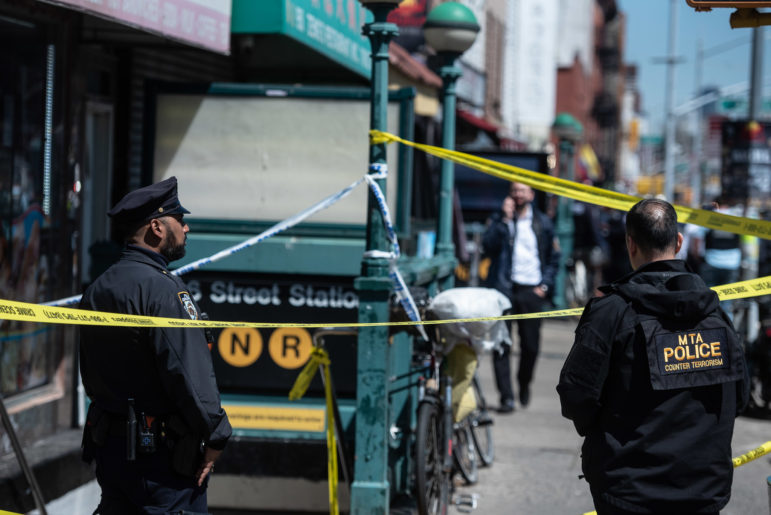“The tragedy occurred despite the massive resources poured into NYPD and the continued expansion of its law enforcement powers.”

Michael Appleton/Mayoral Photography Office
The scene outside the 36th Street Subway station in Sunset Park, Brooklyn after Tuesday’s shooting.As New Yorkers, we pride ourselves on our resilience and superhero-like ability to overcome even the worst tragedies. Yet, the events that unfolded on the subway on Tuesday have most of us on edge, and rightfully so. As I waited over an hour for an Uber, I wondered if I should get on the train back home to Queens from Manhattan—but then remembered being on a Brooklyn-bound train that morning and hearing about a shooting, and worrying that we’d never make it to a station.
In the wake of this tragedy, the simple assumption will be that expanded policing is the right response. But that couldn’t be more wrong. This shooting—in the face of a massive expansion of the police presence on the subway and elsewhere in the city—actually demonstrates the limits of “tough on crime” policies.
Over the past few months, New York’s new mayor has flooded the subway with more than 1,000 extra police officers, many paid overtime, with the goal of keeping commuters safe. This has been the largest law enforcement presence in the subway in 26 years for the Transit Bureau. The mayor has also recommissioned a controversial plainclothes anti-crime police unit that was responsible for a number of shootings and launched a full-throated attack on the city’s cash bail reforms. Since the beginning of the year, the NYPD has increased arrests on the subway by over 64 percent compared to last year. There have been 350 fare evasion arrests and 17,000 summons since January.
And that doesn’t take into account the already extraordinary reach of the NYPD, which now has an annual budget that exceeds $10 billion and spent $474 million on overtime. This is a police department that owns a bulletproof boat and six submarine drones—but whose radios weren’t working during Tuesday’s attack.
The tragedy occurred despite the massive resources poured into NYPD and the continued expansion of its law enforcement powers. At least 23 people on their way to school, work, and home, were injured as one man fired his handgun at the 36th Street station. It’s time to think beyond the police when it comes to public safety. If Tuesday’s events have taught us anything, it is that an increase in police presence and spending does not correlate with an increase in safety.
Instead, hyper-policing correlates with an increase in racial profiling, excessive use of force, and further oppression of Black and brown communities as more people are arrested for low-level offenses—often resulting in pre-trial detention that causes a person to lose housing and employment—while white and Asian commuters are left in peace. Instead of doubling down on a failed approach and investing in more police officers, Adams needs to invest in evidence-based alternatives to policing to address issues such as gun violence, trash pick-up, houselessness, and mental health struggles. Case studies show that access to housing, employment, sanitation services, healthcare, and other social services help to decrease crime. Adams’ approach needs to promote both public safety and health without further harming historically oppressed communities.
Preventing the kind of violence we saw this week requires a more surgical approach that deals with extremist ideologies spewed by the suspect. Our city needs a more thoughtful and balanced approach by our mayor, one without the blindspots exposed during Tuesday’s attack.
A safer New York does not need to look like a military state, and we should not create an atmosphere of fear and anxiety. This is a quality of life issue. I, for one, would like to take my son on the subway into Manhattan without the fear of him getting hurt, but at the same time, without needing a police officer at every station, in every train car to feel safe. Solely relying on police presence to prevent crime not only doesn’t work—as Tuesday’s shooting demonstrates—it also prevents us from tackling the systemic issues that pose a real threat to our great city. Without addressing factors such as poor mental health services in our communities made vulnerable by poverty, underfunded institutions, and underemployment, we are setting ourselves up for failure. In fact, according to a recent survey, New Yorkers already know that policing shouldn’t be our top and only priority with many of us pointing to affordable housing being key to keeping our city safe.
We cannot look backward for a solution to current issues. Old school tactics like stop and frisk hurt us by having negative mental health effects on young people in communities of color and can lead to indiscriminate use of force. They also have a minimal positive impact in lowering crime. Over the past few weeks, we saw more police officers in the subway conducting bag searches, yet here we are again, as a city needing to heal from another traumatic event.
Mayor Eric Adams, you promised us a safer New York for all, and it’s time you fulfill that promise before more New Yorkers get hurt. It’s time you look to the future and take on this common-sense position: innovative solutions for a safer city.
Aliyah Salim is a program associate at Galaxy Gives and an Indo-Guyanese feminist and activist working to build power in her community. A survivor herself, Aliyah’s work focuses on building the leadership and capacity of survivors of violence.








